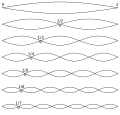Sensory Neuroscience: Hearing and speech/Sound/physics
The nature of sound
Sound is the sensing of a vibration as it propagates trough a medium. Without a medium, there can be no sound. The speed of propagation depends on the elasticity and density of the medium, the medium itself is not required to move, it the terms that it is only required to support the propagation of the vibration.
Sound depends not only on the point of the initiation of vibration (origin), since the medium may absorb or alter the propagation of the vibratory waves it is dependent also on the location of where the sensing is done and the sensor capabilities of processing those sound waves, as waves may have different frequencies.

Pure tones have sinusoidal waves, as shown at left.
Inverse-square law

The inverse-square law states that the amount of sound energy decreases inversely proportional to the square of the distance from the source of the sound. Thus, the law describes how sound intensity decreases with distance from the sound's source via a simple equation.
- r is the radius = distance from the source to the location of measurement
So, amplitude drops by a factor of 9 when the radius triples. Template:-
Impedence mismatch problem

If you play around with the equation, you'll find that the more different the values for and are, the less transmission of amplitude there is from medium 1 to medium 2. The energy which doesn't get transmitted into the next medium is reflected of the interface.
Amplitude gets scaled down according to the above equation - all other properties remain unaffected. Template:-
Diffraction
There are four cases:

- Small opening
- The opening is smaller than the wavelength.
- A new source "recycles" the energy at the opening & it radiates out spherically.
- Large opening
- The opening is larger than the wavelength.
- Waves continue along straight through the opening - no radiation.
- Small obstacle
- The obstacle is smaller than the wavelength.
- The wave propagates around the obstacle.
- Large obstacle
- A "shadow" of the obstruction exists on the other side.
Interference

When waveforms interact, they add up linearly.
-
Constructive interference: the amplitude of the combined waveform is larger than either of the initial waveforms.
-
Destructive interference: the amplitude of the combined waveform is smaller (here, zero) than either of the initial waveforms.
Standing waves
- The lowest frequency at which a standing wave will exist is the fundamental frequency, , and has a wavelength of twice the length.
- Other standing waves have multiples of 's wavelength.
- For a tube with one end closed, only the odd multiples of support a standing wave, and is .
- This is a model for the ear canal.
Measuring amplitude
Amplitude corresponds to loudness - it's a measurement of how much energy the waveform contains.
Measurement is easy for pure tones, but for complex sounds, you must take repeated measures and average it out using a method we won't cover. It's not very useful to measure loudness in terms of pressure directly since we deal with such a large range of values (millions of orders of magnitude). Instead, we use the decibel scale:
Having multiple standards is perverse, but we do it anyway:
- As a standard, is often - this is called "sound pressure level" (30dB SPL). This is most useful for physical measurements.
- As another standard, audiologists often set as the normal human hearing threshold for that sound - this is called hearing level (30dB HL). This is most useful for audiologists, because it indicates whether you can hear normally.
- As yet another standard, researchers often set as the listener's own threshold for that sound - this is called sensitivity level (30dB SL). This is useful for example if you wanted to compare the ability to discriminate between 2 sounds for a normally-hearing person to a hard-of-hearing person.






